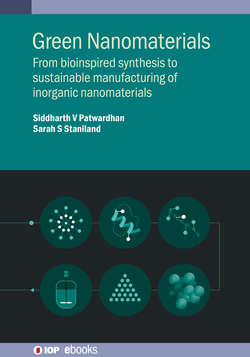Читать книгу Green Nanomaterials - Siddharth Patwardhan - Страница 17
На сайте Литреса книга снята с продажи.
2.2 Tangible and historical examples of nanomaterials
ОглавлениеIt is no coincidence that nanoscience has grown in parallel with the growth and development of instrumentation, imaging and spectroscopic techniques that have the resolution to allow probing on the nano- to the atomic scale (see characterisation in chapter 3). This has been essential to analyse and understand these materials as well as aid design and synthesis. However, while we may not have been able to visualise or understand them, we have been using the properties of nanomaterials for millennia, with examples stretching through history (figure 2.4). One of the earliest examples is the 4th century Roman Lycurgus cup. This beautiful glass cup, mounted in a carved bronze exterior, is now housed in the British Museum. It is an excellent example of nano-optics (specifically surface plasmon resonance), where, because it contains different metallic nanoparticles it looks green if illuminated from the front, because silver nanoparticles scatter the reflective light, and red if illuminated from behind, due to surface plasmon resonance from the gold nanoparticles interacting with transmitted light. It was not until 1847 that Faraday first reported nanoparticles; gold nanoparticles, as a colloidal suspension, he called a ‘gold sol’. He was the first to recognise and describe the exotic optical properties gold nanoparticles possess, which is perhaps the first recognition of quantum size effects and thus quantum mechanics. Not quite so complex but equally dramatic and awe-inspiring, stained glass windows have been used for centuries in religious buildings. Again, metallic nanoparticles are responsible for the incredible colour still enjoyed today in these and also in ceramic glazes, centuries after they were created. The photo sensitivity of silver was developed during the 1800s to invent photography and film (the origin of the term ‘silver screen’) as we knew it up until the late 20th century. While digital imaging has now overtaken film to become the norm, many professionals still prefer traditional film for its distinctive look, and also for its better resolution. Colloid silver on film has nanoscale resolution! The later 20th century saw the explosion of nanomaterials, both in their own right (the subject of this book) and for inclusion in many consumer products, such as solar photovoltaic materials in solar panels and tyres. We even now see silver nanoparticles embedded into socks to for their antimicrobial properties, to stop them smelling! In the present day, our understanding of nanoproperties and ability to make and characterise nanomaterials is growing, and so too is our ambition for their use. The field of nanomedicine has been explored in recent years, and is the subject of section 2.4.1. While curing disease is one of the key applications, it is also the aim of nanoscientists globally to create the smallest working nanomachines, using classic engineering shapes such as axials, rings and wheels at a molecular scale, to make nanowalkers, molecular motors and nanocars [1].
Figure 2.4. Schematic of nanoscale materials and accompanying timeline of their development.
